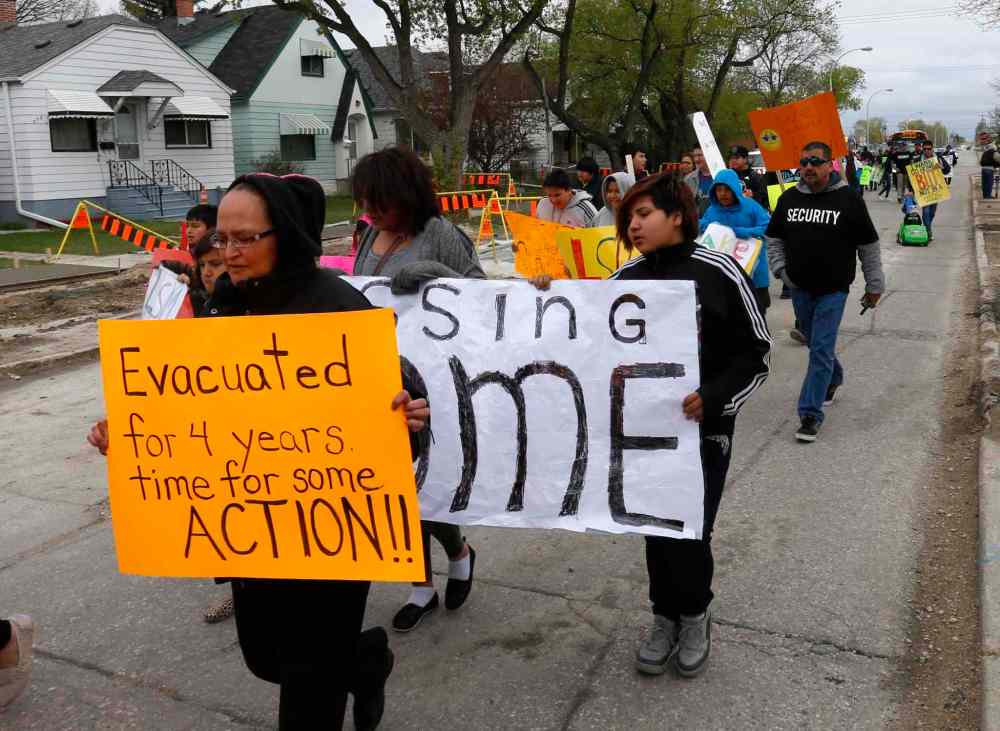Lake St. Martin and Little Saskatchewan evacuees march downtown, ask public to help them
Advertisement
Read this article for free:
or
Already have an account? Log in here »
To continue reading, please subscribe:
Monthly Digital Subscription
$1 per week for 24 weeks*
- Enjoy unlimited reading on winnipegfreepress.com
- Read the E-Edition, our digital replica newspaper
- Access News Break, our award-winning app
- Play interactive puzzles
*Billed as $4.00 plus GST every four weeks. After 24 weeks, price increases to the regular rate of $19.00 plus GST every four weeks. Offer available to new and qualified returning subscribers only. Cancel any time.
Monthly Digital Subscription
$4.75/week*
- Enjoy unlimited reading on winnipegfreepress.com
- Read the E-Edition, our digital replica newspaper
- Access News Break, our award-winning app
- Play interactive puzzles
*Billed as $19 plus GST every four weeks. Cancel any time.
To continue reading, please subscribe:
Add Free Press access to your Brandon Sun subscription for only an additional
$1 for the first 4 weeks*
*Your next subscription payment will increase by $1.00 and you will be charged $16.99 plus GST for four weeks. After four weeks, your payment will increase to $23.99 plus GST every four weeks.
Read unlimited articles for free today:
or
Already have an account? Log in here »
Hey there, time traveller!
This article was published 08/05/2015 (3829 days ago), so information in it may no longer be current.
Dozens of people who were evacuated from the Interlake First Nations of Lake St. Martin and Little Saskatchewan protested the fourth year of exile from their rural homes with rallies Friday.
They gathered outside the downtown federal offices of Aboriginal Affairs on Hargrave Street before moving on to the Legislature.
“We are asking the public to assist us, to push the government on this operation to return home,” Lake St. Martin Chief Adrian Sinclair said. “You can see the people here. They want answers. They’re grassroots people. They’re suffering in the city.”

Some 1,200 evacuees live in apartment and home rentals, administered with federal and provincial funding by the Canadian Red Cross. Another 374 evacuees from Little Saskatchewan are also in Winnipeg, some still in hotels for the past four years.
In total nearly 2,000 remain in the city, including evacuees from Dauphin River and Pinaymootang First Nations.
Chiefs and government officials report there have been plenty of meetings to find a way to get people back home, but there are also stumbling blocks, including the bureaucracy itself and the massive scope of the resettlement.
Little Saskatchewan leaders say talks there have been stalled since last November over a controversial easement the province insists the First Nation sign. They say if they sign, they could lose 80 per cent of the reserve land base to future flooding.
With half the population living on the reserve and the other half in houses and hotels in Winnipeg, the band countered with a demand resettlement include new house for more than simply the evacuees. They also want homes for the kids who’ve grown up on the streets of Winnipeg and now have their own families, plus the people who stayed behind.
That amounts to a brand new community for the entire population or about 600 people.
“I’m getting to the point of doing roadblocks or something. The cottage owners in this province who were affected by the flood are already back home, after two years. So why does it take our First Nations four years and we didn’t see one house built in our community yet?” Councillor Darrell Shorting said.
He said he’s attended one meeting with the federal appointee to the file and the provincial representative since January. Another meeting is planned for next week.
“The meetings fall on deaf ears,” Shorting said.
There are a lot of evacuees who disagree with him. They say their leaders should settle the evacuees first, never mind housing for people who stayed behind at home in 2011. One deal that would have seen 80 new homes on Little Saskatchewan fell apart nearly three years ago over internal politics.
At Lake St. Martin, the community has signed off on a parcel of land, adjacent to the Interlake reserve but it’s not high ground and there’s still a lot of work, including drainage and infrastructure to be put in place before any houses can be built.
“I don’t want to control the funding,” Lake St. Martin Chief Adrian Sinclair said in an interview this week. “I just want the best for my community.”
The chief, a fisherman by trade, once ran a fleet of six boats on Lake St. Martin. He now lives in a rented farmhouse on the outskirts of Winnipeg and finds the bureaucracy involved in the process to be a strain.
“There’s the infrastructure, hydro services, the tendering process for the (land) drainage, and then the infrastructure for the school, and the lots,” he said. Plans call for 285-300 housing lots eventually, beginning with 33 houses. He said he’s still working on getting a paved stretch of highway into the location. Government talks don’t include the community’s dream to have higher land, elsewhere in the RM of Grahamdale, and a location on Highway 6 that they can develop commercially to earn revenue for the First Nation.
Meanwhile Sinclair ticked off the toll Lake St. Martin evacuees have paid in the last four years:
Seventy deaths, constant trouble with CFS, suicides, dialysis and diabetes among elders , gangs recruiting teenagers, drugs, alcohol, family breakdowns, reserve infighting, political scandals.
“I’ve been working with government but it’s very hard,” he said.

